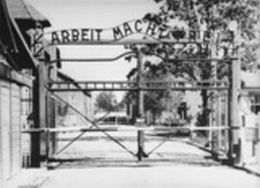« Bad Math | Main | Did We Scare Ya? »
January 27, 2005
Remembering the Wannsee Conference and the Liberation of Auschwitz

This article is posted by participants of the January 27, 2005, BlogBurst (see the list of the over 170 participants), to remember the liberation of the Auschwitz death camp, sixty years ago, on January 27, 1945.
On January 20th, we marked the anniversary of the 1942 Wannsee Conference. In the course of that Conference, the Nazi hierarchy formalized the plan to annihilate the Jewish people. Understanding the horrors of Auschwitz requires that one be aware of the premeditated mass-murder that was presented at Wannsee.
Highlighting these events now has become particularly important, even as the press reports that '45% of Britons have never heard of Auschwitz' (Jerusalem Post, December 2, 2004, http://www.jpost.com/servlet/Satellite?pagename=JPost/JPArticle/ShowFull&cid=1101960938940).
The meeting at Wannsee established the mechanism for "the final solution"—shipment of Jews to eastern labor and death camps—as the official policy of the Third Reich. Ever efficient and unashamed, the Nazi kept a record of the meeting, which were discovered in 1947 in the files of the German Foreign Office.
The conference addressed every aspect of Nazi genocide in chillingly ordinary logic and language, e.g., "Europe will be combed through from West to East," "forcing the Jews out of the various spheres of life of the German people." Ever efficient, the participants foresaw that, "[i]n the course of the final solution and under appropriate direction, the Jews are to be utilized for work in the East in a suitable manner. In large labor columns and separated by sexes, Jews capable of working will be dispatched to these regions to build roads, and in the process a large number of them will undoubtedly drop out by way of natural attrition."
The minutes reflect an intention to dispose of "roughly eleven million Jews." This figure was derived after a horrifyingly detailed discussion of those with only partial Jewish ancestry, sparing some only a quarter Jewish, and magnanimously exempting others from evacuation only if "sterilized in order to prevent any progeny . . . Sterilization will be voluntary, but it is the precondition for remaining in the Reich."
Many conference participants survived the war to be convicted at Nuremberg. The conference, and the bureaucratic sounding murderous minutes, provide a prototypical example of Hannah Arendt's Banality of Evil.
The Holocaust, symbolized by Auschwitz, the worst of the death camps, occurred in the wake of consistent, systematic, unrelenting anti-Jewish propaganda campaign. As a result, the elimination of the Jews from German society was accepted as axiomatic, leaving open only two questions: when and how.
As Germany expanded its domination and occupation of Austria, Czechoslovakia, France, the Low Countries, Yugoslavia, Poland, parts of the USSR, Greece, Romania, Hungary, Italy and others countries, the way was open for Hitler to realize his well-publicized plan of destroying the Jewish people.
After experimentation, the use of Zyklon B on unsuspecting victim was adopted by the Nazis as the means of choice, and Auschwitz was selected as the main factory of death (more accurately, one should refer to the “Auschwitz-Birkenau complex”). The green light for mass annihilation was given at the Wannsee Conference, January 20, 1942, and the mass gassings took place in Auschwitz between 1942 and the end of 1944, when the Nazis retreated before the advancing Red Army. Jews were transported to Auschwitz from all over Nazi-occupied or Nazi-dominated Europe and most were slaughtered in Auschwitz upon arrival, sometimes as many as 12,000 in one day. Some victims were selected for slave labour or “medical” experimentation. All were subject to brutal treatment.
In all, between three and four million people, mostly Jews, but also Poles and Red Army POWs, were slaughtered in Auschwitz alone (though some authors put the number at 1.3 million). Other death camps were located at Sobibor, Chelmno, Belzec (Belzek), Majdanek and Treblinka.
Auschwitz was liberated by the Red Army on 27 January 1945, sixty years ago, after most of the prisoners were forced into a Death March westwards. The Red Army found in Auschwitz about 7,600 survivors, but not all could be saved.
For a long time, the Allies were well aware of the mass murder, but deliberately refused to bomb the camp or the railways leading to it. Ironically, during the Polish uprising, the Allies had no hesitation in flying aid to Warsaw, sometimes flying right over Auschwitz.
There are troubling parallels between the systematic vilification of Jews before the Holocaust and the current vilification of the Jewish people and Israel. Suffice it to note the annual flood of anti-Israel resolutions at the UN; or the public opinion polls taken in Europe, which single out Israel as a danger to world peace; or the divestment campaigns being waged in the US against Israel; or the attempts to delegitimize Israel’s very existence. The complicity of the Allies in WW II is mirrored by the support the PLO has been receiving from Europe, China and Russia to this very day.
If remembering Auschwitz should teach us anything, it is that we must all support Israel and the Jewish people against the vilification and the complicity we are witnessing, knowing where it inevitably leads.
Such remembrance is not a mere recollection of history, it is a reflection upon the eternal evil that is seered into the consciousness of those who lived through it and a forceful reminder to all mankind: "Never again."
Posted by Kelvin at January 27, 2005 7:39 AM
Trackback Pings
TrackBack URL for this entry:
http://www.kelvin-chan.net/mt/mt-tb.cgi/31
Comments
Post a comment
Thanks for signing in, . Now you can comment. (sign out)
(If you haven't left a comment here before, you may need to be approved by the site owner before your comment will appear. Until then, it won't appear on the entry. Thanks for waiting.)